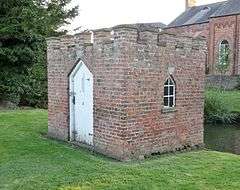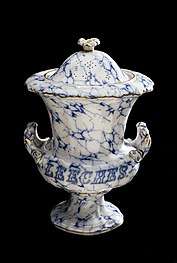Bedale Leech House
This late Georgian Bedale Leech House in Bedale, North Yorkshire, England, is a unique example[1] of a building constructed to keep live medicinal leeches (Hirudo medicinalis) healthy prior to their sale by the local apothecary[2] to doctors and private individuals for the purpose of blood letting as a medical procedure to cure or prevent a variety of illnesses and diseases.[3]
| Bedale Leech House | |
|---|---|
The Leech House | |
 The Bedale Leech House | |
 Location within North Yorkshire | |
| General information | |
| Type | Leech House |
| Location | Bedale, North Yorkshire, England |
| Coordinates | 54.289178°N 1.5895870°W |
| Completed | 19th century |
| Owner | Bedale Heritage Trust |
| Height | 3.25m |
| Dimensions | |
| Diameter | 3.07m |
Listed Building – Grade II | |
| Designated | 25 September 1985 |
| Reference no. | 1150909 |
The Leech house
The 'Leechery' is a small brick built and castellated structure, measuring 10.7 feet (3.25 m) by 10.1 feet (3.07 m), which stands on the bank of the Bedale Beck.[4] It was restored by the Bedale District Heritage Trust in 1985 and sits in a quarter of an acre of gardens known as the 'Bedale Renaissance Park'[5] with an information board that explains its history and significance. It was built by an apothecary on the estate of the Beresford-Pierse family of Bedale Hall in the late 18th or early 19th century[6][7][8] and was used for storing leeches until the early 1900s.[4]
Operation

The leeches were kept in special containers of moist turf and moss and a flow of fresh water from the Bedale Beck was diverted through the building.[9] A fireplace provided heat to ensure the containers and the leeches within did not freeze in winter.[4] Specialized and often very ornate 'Leech Jars' with a secure lid and small pierced air holes were used for the storage of leeches in the apothecary's shop. Feeding was not usually necessary as leeches can survive for lengthy periods, up to a year, between meals.[10]
The leeches were collected using either horses or, frequently, the legs of the leech collectors themselves. A leech was removed after it had taken a full meal of blood.[11] Bogs and marshes were the best collecting areas; the Lake District and Somerset Levels had particularly suitable sites. Women were particularly associated with collecting leeches and transporting them in small boxes or cages.[12][10] It was not until 1835 that a method of breeding medicinal leeches was perfected in France; however, the British showed little interest in this, even though the native stocks were in decline or nearing extinction.[13]
At Bedale, George Thornton was the leech gatherer who was employed by Mr. Bellamy a local pharmacist or apothecary.[14] Special pewter boxes were developed into which the leeches were placed once sold.[10]
The use of leeches in medicine reached a peak between 1825 and 1850 to the point that supplies became scarce[15] and a secure place to store them before use became desirable. By the 1900s the use of leeches in medicine had dramatically declined and the Bedale Leech House ceased to be used for their storage, though it survived until its restoration in 1985. In the same year as its restoration, it was noted by Historic England as being a grade II listed building.[16]
References
- "Bedale - The Heart of North Yorkshire". Archived from the original on 11 October 2016. Retrieved 24 September 2016.
- Kirk, p.92
- Welcome to Yorkshire
- "Bloodsuckers' home for sale". BBC News. 26 November 2003. Retrieved 22 August 2019.
- Medical Heritage - Yorkshire and Cleveland Archived 3 March 2016 at the Wayback Machine
- Kirk, p.92
- Britain Express
- Alamy Photographs
- The Northern Echo
- The Virtual Victorian
- Leech collectors, Science Museum. Accessed 24 September 2016.
- Robinson. pp.54–56.
- Kirk, p.92
- Yorkshire Gazetteer
- Hirudo medicinalis: ancient origins of, and trends in the use of medicinal leeches throughout history
- Historic England. "The Leech House (Grade II) (1150909)". National Heritage List for England. Retrieved 22 August 2019.
- Sources
- Kirk, Robert & Pemberton, Neil (2013). Leech. Reaktion Books,
- Robinson, Tony. The Worst Jobs in History. Pan. ISBN 0-330-43857-3
External links
| Wikimedia Commons has media related to Bedale Medicinal Leech House. |